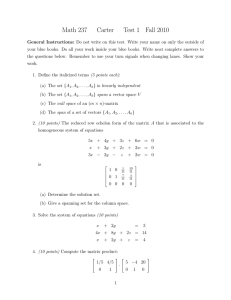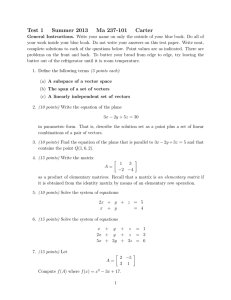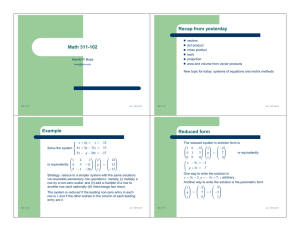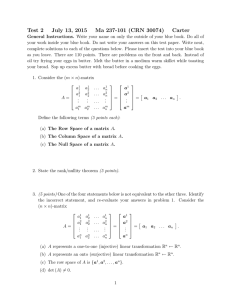Math 2270 § 1. First Midterm Exam Name: −
advertisement
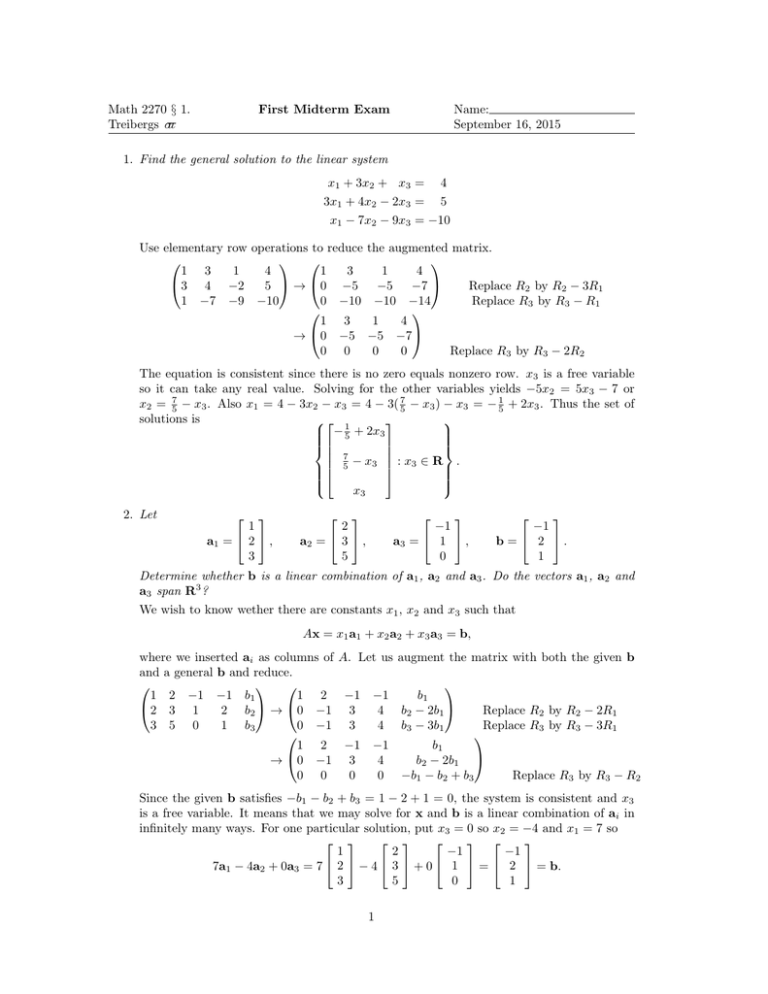
Math 2270 § 1.
Treibergs σ−
ιι
First Midterm Exam
Name:
September 16, 2015
1. Find the general solution to the linear system
x1 + 3x2 + x3 =
4
3x1 + 4x2 − 2x3 =
5
x1 − 7x2 − 9x3 = −10
Use elementary
1 3
3 4
1 −7
row operations to reduce
1
4
1
3
−2
5 → 0 −5
−9 −10
0 −10
1 3
→ 0 −5
0 0
the augmented matrix.
1
4
−5 −7
Replace R2 by R2 − 3R1
−10 −14
Replace R3 by R3 − R1
1
4
−5 −7
Replace R3 by R3 − 2R2
0
0
The equation is consistent since there is no zero equals nonzero row. x3 is a free variable
so it can take any real value. Solving for the other variables yields −5x2 = 5x3 − 7 or
x2 = 57 − x3 . Also x1 = 4 − 3x2 − x3 = 4 − 3( 75 − x3 ) − x3 = − 51 + 2x3 . Thus the set of
solutions is
1
− 5 + 2x3
7
− x3 : x3 ∈ R .
5
x3
2. Let
1
a1 = 2 ,
3
−1
a3 = 1 ,
0
2
a2 = 3 ,
5
−1
b = 2 .
1
Determine whether b is a linear combination of a1 , a2 and a3 . Do the vectors a1 , a2 and
a3 span R3 ?
We wish to know wether there are constants x1 , x2 and x3 such that
Ax = x1 a1 + x2 a2 + x3 a3 = b,
where we inserted ai as columns of A. Let us
and a general b and reduce.
1 2 −1 −1 b1
1 2 −1 −1
2 3 1
2 b2 → 0 −1 3
4
3 5 0
1 b3
0 −1 3
4
1 2 −1 −1
4
→ 0 −1 3
0 0
0
0
augment the matrix with both the given b
b1
b2 − 2b1
b3 − 3b1
Replace R2 by R2 − 2R1
Replace R3 by R3 − 3R1
b1
b2 − 2b1
−b1 − b2 + b3
Replace R3 by R3 − R2
Since the given b satisfies −b1 − b2 + b3 = 1 − 2 + 1 = 0, the system is consistent and x3
is a free variable. It means that we may solve for x and b is a linear combination of ai in
infinitely many ways. For one particular solution, put x3 = 0 so x2 = −4 and x1 = 7 so
1
2
−1
−1
7a1 − 4a2 + 0a3 = 7 2 − 4 3 + 0 1 = 2 = b.
3
5
0
1
1
To determine whether a1 , a2 and a3 span R3 , we need to know whether the equation
Ax = x1 a1 + x2 a2 + x3 a3 = b.
can be solved for any b. But, this is not possible because, for the last row to be consistent,
namely zero equals zero, the vector b has to satisfy −b1 − b2 + b3 = 0. But not all b satisfy
this equation, thus the system cannot be solved for all b so the vectors a1 , a2 and a3 don’t
span R3 . We could also see this by noticing that the not every row of the row-echelon
matrix of A has a pivot.
3. Define the map T : R3 → R2 by
T (x) = Ax =
3
1
2
2
1
3
x1
x2
x3
Define: T (x) is a linear transformation. Is T (x) a linear transformation? Explain why or
why not. Define: The map T (x) is onto. Is T (x) onto? Explain why or why not. Define:
The map T (x) is one-to-one. Is T (x) one-to-one? Explain why or why not.
A map T : R3 → R2 is a linear transformation if (1) T (u + v) = T (u) + T (v) for all
u, v ∈ R3 and (2) T (cu) = cT (u) for every c ∈ R and every u ∈ R3 . These properties hold
for T (x) = Ax as a result of properties of matrix multiplication. Indeed, (1) T (u + v) =
A(u+v) = Au+Av = T (u)+T (v) for all u, v ∈ R3 and (2) T (cu) = A(cu) = cAu = cT (u)
for every c ∈ R and every u ∈ R3 .
A map T : R3 → R2 is onto if for every b ∈ R2 there is a x ∈ R3 such that T (x) = Ax = b.
Writing the equation as an augmented matrix,
3
1
2
2
1 b1
3 b2
→
→
1
3
2
2
1
0
2
−4
3
1
b2
b1
3
−8
Swap R1 and R2
b2
b1 − 3b2
Replace R2 and R2 − 3R1
There is a pivot entry in every row, so that no matter what b is, it can be solved for x. Since
x3 is free it can be taken to be any number. For example, if x3 = 0 we have x2 = − 41 b1 + 34 b2
and x1 = b2 − 2x2 = b2 − 2(− 14 b1 + 43 b2 ) = 12 b1 − 12 b2 . Thus
1
b1 − 12 b2
2
3 2 1 1
b1
− 4 b1 + 34 b2 =
T (x) = Ax =
.
1 2 3
b2
0
A map T : R3 → R2 is one-to-one if for every b ∈ R2 there is at most one x ∈ R3 such
that T (x) = b. The given map is not one-to-one because we can find at least two x’s that
map to any b. Indeed, if b = 0 then by choosing x3 to be any number, x2 = −2x3 and
x1 = −3x3 − 2x2 = x3 we have
x3
3 2 1
0
−2x3 =
T (x) = Ax =
.
1 2 3
0
x3
Thus infinitely many x’s map to b = 0. Hence the map is not one-to-one. Equivalently,
we could say that T (x) is not one-to-one because the homogeneous equation Ax = 0 has
nontrivial solutions.
2
4. Define: the set of vectors {a1 , a2 , . . . , ap }
set S is linearly independent, where
3
4
S=
1 ,
0
is linearly independent. Determine whether the
2
2
,
1
3
0
−2
1
9
The set of vectors {a1 , a2 , . . . , ap } is linearly independent if the vector equation
x1 a1 + x2 a2 + · · · + xp ap = 0.
has only the all-zero solution (x1 . . . , xp ) = (0, . . . , 0).
Write the dependency
row operations on the
3 2
4 2
1 1
0 3
condition as Ax = 0 where the ai are the columns of A. Elementary
matrix A yield
1 1 1
0
Swap R1 and R3
−2
→ 4 2 −2
3 2 0
1
0 3 9
9
1 1
1
0 −2 −6
Replace R2 by R2 − 4R1
→
0 −1 −3
Replace R3 by R3 − 3R1
0 3
9
1 1
1
0 −2 −6
→
0 0
0
Replace R3 by R3 − 21 R2
0 0
0
Replace R4 by R4 + 32 R2
We see that x3 is a free variable. Thus there are infinitely many solutions so zero is not
the only solution. Thus the vectors are not linearly independent. Alternately, we see that
the third vector is a linear combination of the first two so the vectors are not linearly
independent.
0
2
3
2 −2
4
−2
1 + 3 1 = 1
9
3
0
5. Let T : R2 → R4 be a linear transformation such that
0
2
1
2
1
0
T
=
T
=
0 ,
2 .
0
1
1
0
5
Find T
. Find the standard matrix of T (x) For this transformation T , is there a
10
vector b ∈ R4 such that the system T (x) = b is inconsistent? If there is such b, find one
and check. If there in no such b, explain why not.
Using linearity of T , we see that
0
1
5
1
0
1
0
T
=T 5
+ 10
= 5T
+10T
= 5
0
10
0
1
0
1
1
3
2
20
2 25
+10 =
2 20
0
5
The standard matrix has columns
a1 = T (e1 ) = T
Thus
0
1
A=
0
1
1
0
2
2
2
0
0
1
=
0 ,
1
a2 = T (e2 ) = T
0
1
so T (x) = Ax =
0
1
0
1
2
2
=
2 .
0
2 2
x1 .
2 x2
0
The system T (x) = Ax = b is inconsistent if there is no solution. Notice that both a1 and
a2 have equal first and
components so their linear combinations will do too. Thus we
third
1
0
can show that b =
0 cannot be a linear combination and Ax = b has no solution for
0
this b. To see it, do row operations on the augmented matrix.
Swap R1 and R2
1 2 0
0 1 1
0 1 1
1 2 0
0 2 0 → 0 2 0
1 0 0
1 0 0
1 2 0
0 1 1
→
0 2 0
Replace R4 by R4 − R1
0 −2 0
1 2 0
0 1 1
→
0 0 −2
Replace R3 by R3 − 2R2
0 0 2
Replace R4 by R4 + 2R2
1 2 0
0 1 1
→
0 0 −2
0 0 0
Replace R4 by R4 + R3
The system is inconsistent with this b. The third row says zero equals −2, which cannot
hold.
4
